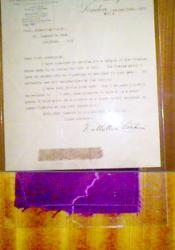Mauveine Dye Patent
William Perkin, and 18-year-old assistant at the Royal College of Chemistry, was given the task of creating quinine, an anti-malarial. After cleaning out the flask of one attempt, he discovered that the solution had turned purple. Initially called aniline purple, after one of the key ingredients, he tested the solution’s ability to dye clothing, and found it took well to fabric. He patented the new dye on August 26th that would be called mauveine, which was one of the world’s first synthetic dyes. With the help of his family, he established a factory to produce the product, and made enough mauveine to bring it into wide use in the Victorian dye market. “Mauveine measles” was a term coined to describe the excitement the dye brought to fashion during the late 1850s and early 1860s. There are several bottles that remain today of Perkin’s mauveine, although studying the contents, scientists cannot produce copies based off Perkin’s patented instructions. There is debate as to whether they are true originals, or if Perkin left out steps in the process.
If William Perkin did hide his actual process, then it is easy to see why in the context of the period. The color purple was restricted to the upper classes for much of history. It was a color that could only be afforded by the wealthiest of society, giving it a reputation as a color of royalty. With Perkin finding a way to synthesize dye artificially, the floodgates opened to allow the masses to afford a color that had never been available to them before. And given its reputation, excitement raged as people sought the new product. Competitors tried to find alternatives to share in the frenzy, so it is understandable if Perkin did not write down the entire process for the world, even in his patent. He made an aspect of the wealthy available to the lower classes, and in turn became very wealthy himself. Mauveine is a fascinating example of the shifting class relations of the Victorian period.
Works Cited
Plater J., 2019, "The mystery of the Victorian purple dye," Research OUTREACH (110). Available at: https://researchoutreach.org/articles/the-mystery-of-the-victorian-purpl... (Accessed 2021/10/25)
Waring, S., 2018, “Mauve Mania,” Science Museum. https://blog.sciencemuseum.org.uk/mauve-mania/. (Accessed 2021/10/26)

